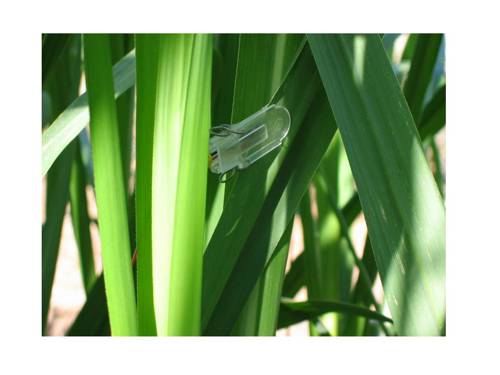
FAQ About Mastering Indoor Plant Watering Sensors

What are indoor plant watering sensors?
Indoor plant watering sensors are devices designed to measure the moisture level in the soil of potted plants. They help gardeners and plant enthusiasts determine when it's time to water their plants, ensuring that they receive the optimal amount of water for healthy growth.

How do watering sensors work?
Watering sensors typically work by inserting probes into the soil of your plant's pot. These probes detect the moisture level based on electrical conductivity. As moisture changes in the soil, so does the conductivity, allowing the sensor to provide a moisture reading.

What are the benefits of using watering sensors for indoor plants?
Using watering sensors can prevent overwatering or underwatering, which are common issues with indoor plants. Sensors ensure that plants get the right amount of water, which can lead to healthier growth, reduced risk of diseases, and less water waste.

Are watering sensors easy to install and use?
Yes, most watering sensors are designed for easy installation and use. They typically require you to simply insert the probe into the soil and sync the device with a smartphone app or monitor, where you can easily view moisture levels and receive watering alerts.

Can watering sensors be used for all types of indoor plants?
Generally, watering sensors can be used for a wide variety of indoor plants. However, it's important to ensure that the sensor's probe can fit comfortably in the pot without damaging the roots, and that the moisture levels provided are suitable for the specific type of plant.

What are the different types of indoor plant watering sensors?
There are several types of watering sensors including basic analog meters, digital sensors with readouts, and smart sensors that connect to smartphone apps. Some advanced models may even include additional features like temperature and light level measurements.

Do watering sensors require batteries?
Most electronic watering sensors do require batteries to operate, particularly for those with digital displays or app connectivity. Analog moisture meters do not require batteries as they work purely on physical principles.

How often should I replace the batteries in my watering sensor?
The frequency with which you should replace batteries depends on the type and model of the watering sensor, as well as how often it is used. Generally, it's recommended to check battery status periodically and replace them as needed when the device indicates low power.

Can watering sensors connect to smart home systems?
Yes, many modern watering sensors are designed to integrate with smart home systems. They may connect via Wi-Fi or Bluetooth, allowing you to monitor and control moisture levels through smart home hubs or apps.

What maintenance do watering sensors require?
Basic maintenance for watering sensors includes regularly cleaning the sensor probes to prevent soil buildup and ensuring that batteries are replaced or recharged in a timely manner. Always refer to the manufacturer’s instructions for specific care guidelines.

How do I calibrate a watering sensor?
Calibration methods can vary between sensors, but generally, you can calibrate a watering sensor by inserting it into soil with a known moisture level and adjusting the sensor settings according to the manufacturer's instructions. Some smart sensors may auto-calibrate.

What factors should I consider when choosing a watering sensor?
Consider factors such as compatibility with your plant types, ease of installation, the technology used (analog, digital, smart), battery life, and additional features such as integration with smart home systems or extra environmental sensors.

Can a watering sensor help in reducing water wastage?
Yes, by providing accurate measurements of soil moisture, watering sensors can help you determine the precise amount of water needed, reducing the risk of overwatering and ensuring that no excess water is wasted.

Are there any limitations to using watering sensors?
Watering sensors can sometimes provide inaccurate readings if not properly placed or calibrated. Additionally, the user must interpret the data correctly to avoid misjudgment in watering needs. Environmental factors such as soil type and salinity can also affect readings.

How can I tell if my watering sensor is providing accurate readings?
To ensure accuracy, regularly test your sensor's readings against manual checks (like feeling the soil with your fingers) and recalibrate the sensor as needed. If discrepancies persist, consider contacting the manufacturer for support.

Can watering sensors be used outdoors?
While many watering sensors are designed for indoor use, some models are also suitable for outdoor use. It's important to check the manufacturer's specifications regarding weather resistance and durability if you plan to use them outside.

Do indoor plant watering sensors also measure other factors like temperature or light?
Some advanced watering sensors come with additional features that can measure temperature, light intensity, and even humidity levels, providing a more comprehensive insight into the plant's environment and needs.

How much do watering sensors typically cost?
The cost of watering sensors varies widely depending on their features and technology. Basic analog models can cost as little as $10, while more advanced digital or smart models can range from $30 to $100 or more.

Are watering sensors compatible with apps?
Many modern watering sensors feature app compatibility, allowing users to monitor moisture levels and set up alerts directly from their smartphones. These apps often provide additional features like watering history and plant care tips.

What should I do if my watering sensor isn’t working properly?
If your watering sensor is not working properly, first ensure that it’s installed correctly and check if the batteries are charged. Clean the sensor’s probes if necessary. Consult the user manual for troubleshooting steps or contact the manufacturer for assistance.
